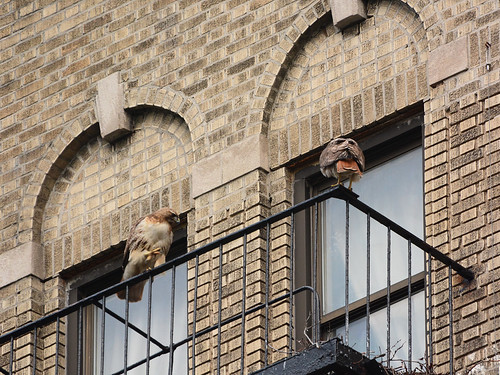What to do about those speck in the sky moments.
From Robin of Illinois who has been periodically seeing a young eagle at a great distance ...
My identification of the glorious eagle is a best
guess based only on size, the mechanism of its wing flapping, and posture when
gliding and obviously, the truly humongous wing span. I've never seen one "in
the wild" and "in person" before!
He/she has been hanging around for about a month
now, but I don't think it is fresh out of the nest this spring, based on
its flying skills and skills in cruising for prey. It is much much too far away
for me to see any facial details, but I did see it make a very nice landing in
the nearly-tippy-top of a giant old oak tree in the back part of the "oak
lawn"....Maybe a year 2-3 juvenile? Obviously no white head yet.
I don't have any camera lenses powerful enough to
capture this amazing sight at these distances, (about 50-100 yards). But
thrilled just to see it!
That's totally GRAND!!!
Are you viewing it with the naked eye? Binoculars? Scope?
While outside? Inside?
You have some kind of point and shoot digital camera, yes?
Here's the deal. I'm constantly having to overshoot my equipment
when I'm trying to get a good look at a flying bird. If this is a two
or three year old eagle it will have splotches of white feathers so even
in a very very bad picture there will likely be that contrast so you can age it more nearly, unless it
is tremendously back lit. You can sometimes age a young eagle by looking at an even awful picture.
The
other thing to do is, as it is digital take as many pictures as you can
possibly manage on any given sighting. Make sure you are in auto focus
and just keep pushing that button while the bird is in your view. Luck
is a marvelous thing and with every push you increase your chances that
auto focus may just come through for you enough to learn something new.
If outside and you can manage it, lean your hand, yourself, whatever against a tree, house, something solid to reduce shake. Inside you'll have more options, you can even sit the camera on something while you shoot.
In the open, push your elbows close to your body and hold your breath for the button push.
Do
you have a photo program? Doesn't have to be photoshop. In fact at
this stage unless you know how to use Photoshop or Light Room trying to
use them will just make you crazy. Go online. There are quite a
number of free photo programs you can download which are simpler so you
can jump right in.. You need something simple enough so you can use it
right away. You will need to be able to manipulate sharpness and
exposure, and the ability to crop freestyle.
A
little speck of a bird, when cropped becomes a much bigger bird, if
much less sharp, which is helpful in gleaning information about it.
If
you have a scope, depending, you may be able to hold the camera to the
eyepiece and do some rough digiscoping while watching the live digital
view as well.
Let us see how you do.
And here is the speck in the sky after the photo which heads the blog was cropped down to a much tinier photo which when enlarged gives us the shape of the bird and in this case because of the folded neck and my knowledge of the area, makes it the Great Blue Heron who traverses the sky every morning and afternoon at about the same time at this location.
And an update on the Trio of Terror plus one, i.e., Quicksilver the African Parrot, Tig the Basenji, Squirrel the Cat... and Pyewacket who could do without every single one of them.
I was walking past the laundry room, glanced in, and saw Quicksilver the African Grey Parrot advancing on the trash can. Not only might there be interesting things in the refuse receptacle but pulled over it makes...what? A cavity!
As I'm putting him back on his perch and telling him NOT to mess with the trash can, I hear the door jangle on the cage I was about to clean in the other room. Hmmm.
I go to investigate.
Tig the Basenji has opened the door of the cage wider with his nose and is helping himself to Nutri-berry fragments on the bottom of the case.
A digression:
Nutri-berries are little balls of bird seed stuck together with pieces of papaya and bird vitamins.
Why is a dog eating bird seed and papaya? Because the parrot eats them and Tig will eat anything the other pets eat no matter how far the food is from that typical of his own species out of sheer jealousy.
While I am shooing the dog out of the bird cage I hear a clatter in the laundry room.
You guessed it. It took the parrot no time at all to leap off his perch and dump the trash. And who is watching all this just in case something of interest might be mined from the refuse?
Squirrel the Cat of course.
All this is only a mini moment of multi-misbehavior that I have managed to nip in the bud, but the day is yet young. And the reason why...
...Pyewacket the Good Pet looks so disgruntled all the time.
(Pye's photograph appears particularly for Karen Anne of the Gonzo Deck who asked how Pye was faring these days.)
Donegal Browne














































